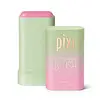What's inside
What's inside
 Key Ingredients
Key Ingredients

 Benefits
Benefits

 Concerns
Concerns

 Ingredients Side-by-side
Ingredients Side-by-side

Hydrogenated Polyisobutene
EmollientDiisostearyl Malate
EmollientCaprylic/Capric Triglyceride
MaskingSynthetic Wax
AbrasiveBis-Diglyceryl Polyacyladipate-2
EmollientSynthetic Beeswax
Emulsion StabilisingCandelilla Cera
EmollientRicinus Communis Seed Oil
MaskingHydrogenated Castor Oil
EmollientTocopheryl Acetate
AntioxidantGlycerin
HumectantCitric Acid
BufferingAscorbic Acid
AntioxidantAloe Barbadensis Leaf Extract
EmollientCamellia Sinensis Leaf Extract
AntimicrobialCitrus Limon Fruit Extract
MaskingFragaria Chiloensis Fruit Extract
Skin ConditioningHamamelis Virginiana Extract
AntiseborrhoeicPanax Ginseng Root Extract
EmollientPyrus Malus Fruit Extract
Skin ConditioningRubus Idaeus Fruit Extract
AstringentVaccinium Angustifolium Fruit Extract
Skin ProtectingVitis Vinifera Fruit Extract
Skin ConditioningPolyglyceryl-2 Triisostearate
EmulsifyingCeramide AP
Skin Conditioning1,2-Hexanediol
Skin ConditioningPhenoxyethanol
PreservativeCI 77891
Cosmetic ColorantIron Oxides
CI 15850
Cosmetic ColorantCI 45410
Cosmetic ColorantHydrogenated Polyisobutene, Diisostearyl Malate, Caprylic/Capric Triglyceride, Synthetic Wax, Bis-Diglyceryl Polyacyladipate-2, Synthetic Beeswax, Candelilla Cera, Ricinus Communis Seed Oil, Hydrogenated Castor Oil, Tocopheryl Acetate, Glycerin, Citric Acid, Ascorbic Acid, Aloe Barbadensis Leaf Extract, Camellia Sinensis Leaf Extract, Citrus Limon Fruit Extract, Fragaria Chiloensis Fruit Extract, Hamamelis Virginiana Extract, Panax Ginseng Root Extract, Pyrus Malus Fruit Extract, Rubus Idaeus Fruit Extract, Vaccinium Angustifolium Fruit Extract, Vitis Vinifera Fruit Extract, Polyglyceryl-2 Triisostearate, Ceramide AP, 1,2-Hexanediol, Phenoxyethanol, CI 77891, Iron Oxides, CI 15850, CI 45410
Synthetic Fluorphlogopite
Mica
Cosmetic ColorantKaolin
AbrasiveSilica
AbrasiveCaprylyl Glycol
EmollientOctyldodecyl Stearoyl Stearate
EmollientPentylene Glycol
Skin ConditioningEthylhexylglycerin
Skin ConditioningSodium Dehydroacetate
PreservativeParfum
MaskingTocopheryl Acetate
AntioxidantWater
Skin ConditioningGlycerin
HumectantPaeonia Lactiflora Root Extract
Skin ConditioningTrehalose
HumectantTocopherol
AntioxidantPotassium Sorbate
PreservativeSodium Benzoate
MaskingCI 15850
Cosmetic ColorantCI 77491
Cosmetic ColorantCI 77742
Cosmetic ColorantCI 19140
Cosmetic ColorantCI 73360
Cosmetic ColorantCI 77007
Cosmetic ColorantCI 45410
Cosmetic ColorantCI 77891
Cosmetic ColorantSynthetic Fluorphlogopite, Mica, Kaolin, Silica, Caprylyl Glycol, Octyldodecyl Stearoyl Stearate, Pentylene Glycol, Ethylhexylglycerin, Sodium Dehydroacetate, Parfum, Tocopheryl Acetate, Water, Glycerin, Paeonia Lactiflora Root Extract, Trehalose, Tocopherol, Potassium Sorbate, Sodium Benzoate, CI 15850, CI 77491, CI 77742, CI 19140, CI 73360, CI 77007, CI 45410, CI 77891
 Reviews
Reviews

Ingredients Explained
These ingredients are found in both products.
Ingredients higher up in an ingredient list are typically present in a larger amount.
Ci 15850 is the pigment color red. It is an azo dye and created synthetically.
Azo dyes need to be thoroughly purified before use. This allows them to be more stable and longer-lasting.
This ingredient is common in foundations, lipsticks, and blushes. This color is described as brown/orangey red.
It has many secondary names such as Red 6 and Red 7. According to a manufacturer, Red 6 usually contains aluminum.
Learn more about CI 15850CI 45410 is a synthetic red-pigment and dye.
It often goes by both Red 28 or Red 27; manufacturers label both ingredients as CI 45410.
This dye is commonly found in makeup because it imparts a vivid color. Some types of this dye change color based on pH level and interaction with moisture:
Your skin has a natural pH of around 4.5 - 5.5.
According to the FDA, CI 45410 is not permitted for use in eye products.
Red 27 is a flourescein dye and commonly used as a fluorescent tracer in medicine.
Learn more about CI 45410Ci 77891 is a white pigment from Titanium dioxide. It is naturally found in minerals such as rutile and ilmenite.
It's main function is to add a white color to cosmetics. It can also be mixed with other colors to create different shades.
Ci 77891 is commonly found in sunscreens due to its ability to block UV rays.
Learn more about CI 77891Glycerin is already naturally found in your skin. It helps moisturize and protect your skin.
A study from 2016 found glycerin to be more effective as a humectant than AHAs and hyaluronic acid.
As a humectant, it helps the skin stay hydrated by pulling moisture to your skin. The low molecular weight of glycerin allows it to pull moisture into the deeper layers of your skin.
Hydrated skin improves your skin barrier; Your skin barrier helps protect against irritants and bacteria.
Glycerin has also been found to have antimicrobial and antiviral properties. Due to these properties, glycerin is often used in wound and burn treatments.
In cosmetics, glycerin is usually derived from plants such as soybean or palm. However, it can also be sourced from animals, such as tallow or animal fat.
This ingredient is organic, colorless, odorless, and non-toxic.
Glycerin is the name for this ingredient in American English. British English uses Glycerol/Glycerine.
Learn more about GlycerinTocopheryl Acetate is AKA Vitamin E. It is an antioxidant and protects your skin from free radicals. Free radicals damage the skin by breaking down collagen.
One study found using Tocopheryl Acetate with Vitamin C decreased the number of sunburned cells.
Tocopheryl Acetate is commonly found in both skincare and dietary supplements.
Learn more about Tocopheryl Acetate